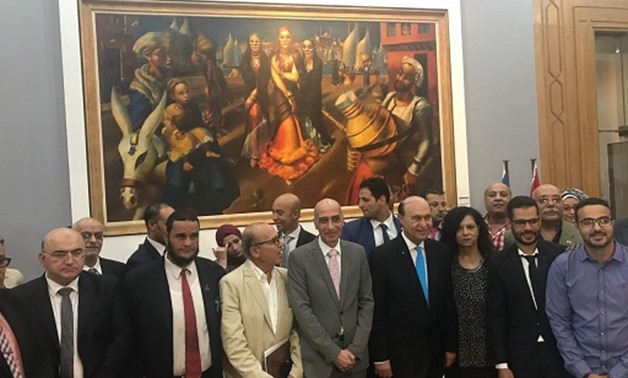
PRESS: Suez Canal Authority Head Mohab Mamish attending a festive exhibition at the Cairo Opera House celebrating 150th anniversary of the Suez Canal inauguration
Cairo – 27 July 2019: Under the auspices of Chairman of the Suez Canal Authority Mohab Mamish and the Ministry of Culture, the Cairo Opera House hosted on Friday a festive exhibition on the occasion of the 150
th anniversary of the Suez Canal inauguration and 63 years since its nationalization.

Organized by the Suez Canal Authority’s historical Gallery under the leadership of Dr. Mona El Sayad, the exhibition was inaugurated by Vice Admiral Mamish and featured 70 works of art by Egyptian artists: between photographs, oil paintings, and wood and matches models that document the legacy of the Canal and immortalize historical architectural buildings and monumental vessels.

“When we review history, we find that the 1956 war started with the Suez Canal, the 1967 war started with the Suez Canal, the war of attrition…, the 1973 war… The next battle is one of development and prosperity and it will also start from the Suez Canal,” Mamish said in a speech. He further referred to the rapid execution of the new Suez Canal, inaugurated in 2015, as an evidence for the capacity and creativity of Egyptians. “We are capable of achieving the impossible,” he stated. “The Suez Canal and the New Canal have become the lifeline for international trade.”

Friday marked 63 years since the nationalization of the Suez Canal on July 26, 1956, by Egyptian President Gamal Abdel Nasser. “Today, we remember our past. We remember the great men who nationalized the Canal and fought for it in great wars, but they managed to win and raised the [Egyptian] flag on the East Coast. They gave up their lives for us to live,” Mamish said, before concluding his speech by expressing his gratitude and appreciation for the artists who have sought to “document the history and write the future of the Suez Canal.”

Following Mamish’s speech, Head of the Fine Arts sector at the Ministry of Culture Dr. Khaled El Said handed in certificates of appreciation to the artists participating in the exhibition.
The exhibition is opened until August 3, in Al Bab Selim and Abaad galleries at Cairo Opera House
Glorious paths cross once again
The Suez Canal and The Cairo Opera House share a history that goes way back, all the way to their very existence.
The original Cairo Opera House, also known as The Khedivial Opera House or Royal Opera House, was initially built in 1869, on the orders of the Khedive Ismail to celebrate the opening of the Suez Canal. Located in the Azbakiya district in central Cairo, it was designed by Italian architects Avoscani and Ross.
That great building unfortunately burned to the ground in October 1971; and it was not until 1988 that the current Cairo Opera House was inaugurated.

A century and half later, the new Opera House once again hosts this festive celebration, to commemorate years of success and glory of the same, yet now even bigger and more significant, international navigation canal that links the Mediterranean Sea with the Red Sea; or more accurately is the getaway to the whole world.

Suez Canal history in a glimpse
The first canal directly linking The Mediterranean Sea to The Red Sea, the Suez Canal was opened for navigation on November 17, 1869. The idea of linking the two seas dates back to over 40 centuries, from the time of the Pharaohs who were actually the first ever to dig a man-made canal connecting the Nile to the Read Sea. Scholars are however still unable to determine if this ancient canal went all the way between the two seas.
The first efforts to build the modern canal came from the French expedition by Napoleon Bonaparte; however, the work was suspended due to miscalculations. Another group of intellectuals regained interest in the project in 1833; yet, Egypt’s ruler at the time Muhamed Ali had little interest in it. In the 1850s, serious studies finally resumed to dig the canal. It was opened in 1869.
The canal remained under the control of Britain and France, until Nasser nationalized it in 1956, which led to the Tripartite British, French, Israeli invasion of Egypt. The three invaders were then forced to withdraw due to political pressure from the United States, the Soviet Union and the United Nations.







Comments
Leave a Comment